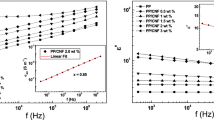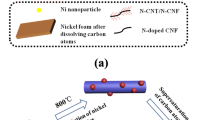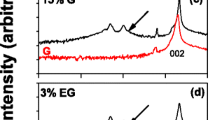Abstract
The aims of this work were analysis of the effect of the synthesis conditions on the microstructure, structure, and electrical properties of electrospun carbon nanofibers/disordered carbon nanotubes (eCNF/dCNT) nanocomposites, and analysis of the correlations between these properties. The nanocomposites were obtained in the combined process involving electrospinning of precursor nanofibers and catalytic chemical vapor deposition (CCVD) synthesis of carbon nanotubes directly on the surface of nanofibers. The evaluation of microstructural-structural characteristics was conducted using microscopic, spectroscopic, and diffractometric methods. Electrical properties were investigated through measurements of temperature-dependent conductivity, and interpreted in terms of Mott's variable range hopping model. The study showed that the control of the temperature and duration of CCVD synthesis of CNT enables tailoring of the microstructure, defect density, and electrical transport in nanocomposites. Increasing the temperature up to 850 °C led to extension of the planar π-conjugated structure of nanoprotrusions, which resulted in facilitated conductivity of nanocomposites. The prolongation of the CCVD growth significantly increased the amount, and length of nanoprotrusions, which resulted in further enhancement of conductivity. The analysis of Raman spectra suggests the existence of an interesting correlation between the half-width of the G-band and T0 parameter describing the electrical properties. The study provides a solid background and route map for the synthesis of eCNF/CNT nanocomposites in applications such as energy storage and conversion, electrochemistry, nanoelectronics, semiconductors etc.
Graphical abstract










Similar content being viewed by others
References
Zander NE (2013) Hierarchically structured electrospun fibers. Polymers (Basel) 5:19–44. https://doi.org/10.3390/polym5010019
Gubernat M, Zambrzycki M, Fraczek-Szczypta A, Blazewicz S (2020) Structural and microstructural study of novel stacked toroidal carbon nanotubes. Micron 130:102816. https://doi.org/10.1016/j.micron.2019.102816
Zambrzycki M, Łoś S, Fraczek-Szczypta A (2021) Structure and electrical transport properties of carbon nanofibres/carbon nanotubes 3D hierarchical nanocomposites: impact of the concentration of acetylacetonate catalyst. Ceram Int 47:4020–4033. https://doi.org/10.1016/j.ceramint.2020.09.269
Zhang H, Liu Y, Tao J, Liu Y, Bao R, Li F, Yi J (2021) Direct synthesis of carbon nanotube-graphene hybrids on copper powders and the mechanical properties of corresponding composites. Mater Sci Eng A 825:141861
Hou H, Reneker DH (2004) Carbon nanotubes on carbon nanofibers: a novel structure based on electrospun polymer nanofibers. Adv Mater 16:69–73. https://doi.org/10.1002/adma.200306205
Lai C, Guo Q, Wu XF, Reneker DH, Hou H (2008) Growth of carbon nanostructures on carbonized electrospun nanofibers with palladium nanoparticles. Nanotechnology 19(19):195303
Alali KT, Liu J, Liu Q et al (2019) Grown carbon nanotubes on electrospun carbon nanofibers as a 3d carbon nanomaterial for high energy storage performance. ChemSelect 4:5437–5458. https://doi.org/10.1002/slct.201803828
Zambrzycki M, Fraczek-Szczypta A (2020) Study on the synthesis and properties of hierarchically structured electrospun/vapour-grown carbon nanofibres nanocomposites. J Ind Eng Chem 86:100–112. https://doi.org/10.1016/j.jiec.2020.02.017
Wang C, Zong L, Pan Y et al (2021) Preparation and characterization of branch-like heteroatoms-doped Ni@C nanofibers for high-performance microwave absorption with thin thickness. Compos Part B Eng 223:109114. https://doi.org/10.1016/j.compositesb.2021.109114
Aftab F, Duran H, Kirchhoff K et al (2020) A facile synthesis of FeCo nanoparticles encapsulated in hierarchical n-doped carbon nanotube/nanofiber hybrids for overall water splitting. ChemCatChem 12:932–943. https://doi.org/10.1002/cctc.201901601
Wang F, Feng X, Wang N et al (2021) In-situ grown nickel-cobalt bimetallic nanowire arrays for efficient hydrogen evolution reaction. Coll Surf A Physicochem Eng Asp 615:126205. https://doi.org/10.1016/j.colsurfa.2021.126205
van Helden P, Prinsloo F, van den Berg JA et al (2020) Cobalt-nickel bimetallic fischer-tropsch catalysts: a combined theoretical and experimental approach. Catal Today 342:88–98. https://doi.org/10.1016/j.cattod.2019.03.001
Long F, Zhang Z, Wang J et al (2015) Cobalt-nickel bimetallic nanoparticles decorated graphene sensitized imprinted electrochemical sensor for determination of octylphenol. Electrochim Acta 168:337–345. https://doi.org/10.1016/j.electacta.2015.04.054
Barakat NA, Motlak M, Lim BH, El-Newehy MH, Al-Deyab SS (2014) Effective and stable CoNi alloy-loaded graphene for ethanol oxidation in alkaline medium. J Electrochem Soc 161(12):1194–1201
Aftab F, Tanveer S, Rehman SU et al (2020) Encapsulation of Fe/Fe3O4 in carbon nanotubes grown over carbon nanofibers for high performance supercapacitor electrodes. Synth Met 269:116575. https://doi.org/10.1016/j.synthmet.2020.116575
Wang T, Song D, Zhao H et al (2015) Facilitated transport channels in carbon nanotube/carbon nanofiber hierarchical composites decorated with manganese dioxide for flexible supercapacitors. J Pow Sour 274:709–717. https://doi.org/10.1016/j.jpowsour.2014.10.102
Qiu Y, Li G, Hou Y et al (2015) Vertically aligned carbon nanotubes on carbon nanofibers: a hierarchical three-dimensional carbon nanostructure for high-energy flexible supercapacitors. Chem Mater 27:1194–1200. https://doi.org/10.1021/cm503784x
Miao F, Shao C, Li X et al (2016) Electrospun carbon nanofibers/carbon nanotubes/polyaniline ternary composites with enhanced electrochemical performance for flexible solid-state supercapacitors. ACS Sustain Chem Eng 4:1689–1696. https://doi.org/10.1021/acssuschemeng.5b01631
Chen Y, Li X, Park K et al (2013) Hollow carbon-nanotube/carbon-nanofiber hybrid anodes for Li-ion batteries. J Am Chem Soc 135:16280–16283. https://doi.org/10.1021/ja408421n
Motlak M, Barakat NAM, Akhtar MS et al (2015) High performance of NiCo nanoparticles-doped carbon nano fibers as counter electrode for dye-sensitized solar cells. Electrochim Acta 160:1–6. https://doi.org/10.1016/j.electacta.2015.02.063
Fontana M, Ramos R, Morin A, Dijon J (2021) Direct growth of carbon nanotubes forests on carbon fibers to replace microporous layers in proton exchange membrane fuel cells. Carbon N Y 172:762–771. https://doi.org/10.1016/j.carbon.2020.10.049
Kuzmenko V, Saleem AM, Staaf H, Haque M, Bhaskar A, Flygare M, Enoksson P (2016) Hierarchical cellulose-derived CNF/CNT composites for electrostatic energy storage. J Micromec Microeng 26(12):124001
Kshetri T, Thanh TD, Singh SB et al (2018) Hierarchical material of carbon nanotubes grown on carbon nanofibers for high performance electrochemical capacitor. Chem Eng J 345:39–47. https://doi.org/10.1016/j.cej.2018.03.143
El Mel AA, Achour A, Xu W, Choi CH, Gautron E, Angleraud B, Tessier PY (2011) Hierarchical carbon nanostructure design: ultra-long carbon nanofibers decorated with carbon nanotubes. Nanotechnology 22(43):435302
Zambrzycki M, Tomala J, Fraczek-Szczypta A (2018) Electrical and mechanical properties of granular-fibrous carbon-carbon composites with recycled carbon fibres. Ceram Int 44:19282–19289. https://doi.org/10.1016/j.ceramint.2018.07.154
Zhan D, Yan J, Lai L et al (2012) Engineering the electronic structure of graphene. Adv Mater 24:4055–4069. https://doi.org/10.1002/adma.201200011
Jin Y, Zheng Y, Podkolzin SG, Lee W (2020) Band gap of reduced graphene oxide tuned by controlling functional groups. J Mater Chem C 8:4885–4894. https://doi.org/10.1039/c9tc07063j
Lefebvre J, Ding J, Li Z et al (2017) High-purity semiconducting single-walled carbon nanotubes: a key enabling material in emerging electronics. Acc Chem Res 50:2479–2486. https://doi.org/10.1021/acs.accounts.7b00234
Stavarache I, Lepadatu A-M, Teodorescu V et al (2011) Electrical behavior of multi-walled carbon nanotube network embedded in amorphous silicon nitride. Nanoscale Res Lett 6:88. https://doi.org/10.1186/1556-276x-6-88
Joung D, Khondaker SI (2012) Efros-shklovskii variable range hopping in reduced graphene oxide sheets of varying carbon sp2 fraction. Phys Rev B 86:29–32
Wang DP, Feldman DE, Perkins BR et al (2007) Hopping conduction in disordered carbon nanotubes. Solid State Commun 142:287–291. https://doi.org/10.1016/j.ssc.2007.02.028
Mott NF (1968) Conduction in glasses containing transition metal ions. J Non Cryst Sol 1:1–17. https://doi.org/10.1016/0022-3093(68)90002-1
Najeh I, El Mir L (2020) Hopping charge transport of the porous carbon. Mater Today Proc 43:3345–3353. https://doi.org/10.1016/j.matpr.2019.12.017
Bhatia R, Kumari K, Rani R et al (2018) A critical review of experimental results on low temperature charge transport in carbon nanotubes based composites. Rev Phys 3:15–25. https://doi.org/10.1016/j.revip.2017.12.001
Xavier PAF, Benoy MD, Stephen SK, Varghese T (2021) Enhanced electrical properties of polyaniline carbon nanotube composites: analysis of temperature dependence of electrical conductivity using variable range hopping and fluctuation induced tunneling models. J Solid State Chem 300:122232. https://doi.org/10.1016/j.jssc.2021.122232
Han W, Zhou Y, Zhu T, Chu H (2020) Combustion synthesis of defect-rich carbon nanotubes as anodes for sodium-ion batteries. Appl Surf Sci 520:146317. https://doi.org/10.1016/j.apsusc.2020.146317
Wojdyr M (2010) Fityk: a general-purpose peak fitting program. J Appl Crystallogr 43:1126–1128. https://doi.org/10.1107/S0021889810030499
Caņado LG, Takai K, Enoki T et al (2006) General equation for the determination of the crystallite size la of nanographite by Raman spectroscopy. Appl Phys Lett 88:1–4. https://doi.org/10.1063/1.2196057
Ferrari A, Robertson J (2000) Interpretation of Raman spectra of disordered and amorphous carbon. Phys Rev B Condens Matter Mater Phys 61:14095–14107. https://doi.org/10.1103/PhysRevB.61.14095
Zhou Z, Wu XF, Fong H (2012) Electrospun carbon nanofibers surface-grafted with vapor-grown carbon nanotubes as hierarchical electrodes for supercapacitors. Appl Phys Lett 100:3–7. https://doi.org/10.1063/1.3676193
Zhou J, Chen J, Han S et al (2017) Constructing optimized three-dimensional electrochemical interface in carbon nanofiber/carbon nanotube hierarchical composites for high-energy-density supercapacitors. Carbon N Y 111:502–512. https://doi.org/10.1016/j.carbon.2016.10.036
Zhou Z, Wu X-F, Hou H (2014) Electrospun carbon nanofibers surface-grown with carbon nanotubes and polyaniline for use as high-performance electrode materials of supercapacitors. RSC Adv 4:23622–23629. https://doi.org/10.1039/C4RA00964A
Benko A, Nocuń M, Gajewska M, Błażewicz M (2019) Addition of carbon nanotubes to electrospun polyacrylonitrile as a way to obtain carbon nano fibers with desired properties. Polym Degrad Stab 161:260–276. https://doi.org/10.1016/j.polymdegradstab.2019.01.033
Sellitti C, Koenig JL, Ishida H (1990) Surface characterization of graphitized carbon fibers by attenuated total reflection fourier transform infrared spectroscopy. Carbon N Y 28:221–228. https://doi.org/10.1016/0008-6223(90)90116-G
El-Kemary M, Nagy N, El-Mehasseb I (2013) Nickel oxide nanoparticles: synthesis and spectral studies of interactions with glucose. Mater Sci Semicond Process 16:1747–1752. https://doi.org/10.1016/j.mssp.2013.05.018
Li Y, Qiu W, Qin F et al (2016) Identification of cobalt oxides with Raman scattering and fourier transform infrared spectroscopy. J Phys Chem C 120:4511–4516. https://doi.org/10.1021/acs.jpcc.5b11185
Zhang T, Huang D, Yang Y et al (2012) Influence of iron (III) acetylacetonate on structure and electrical conductivity of Fe3O4/carbon composite nanofibers. Polym United Kingdom 53:6000–6007. https://doi.org/10.1016/j.polymer.2012.11.015
Li ZQ, Lu CJ, Xia ZP et al (2007) X-ray diffraction patterns of graphite and turbostratic carbon. Carbon N Y 45:1686–1695. https://doi.org/10.1016/j.carbon.2007.03.038
Zhang ZL, Brydson R, Aslam Z et al (2011) Investigating the structure of non-graphitising carbons using electron energy loss spectroscopy in the transmission electron microscope. Carbon N Y 49:5049–5063. https://doi.org/10.1016/j.carbon.2011.07.023
Jurkiewicz K, Pawlyta M, Burian A (2018) Structure of carbon materials explored by local transmission electron microscopy and global powder diffraction probes. C J Carbon Res 4:68. https://doi.org/10.3390/c4040068
Wei XW, Zhou XM, Wu KL, Chen Y (2011) 3-D flower-like NiCo alloy nano/microstructures grown by a surfactant-assisted solvothermal process. CrystEngComm 13:1328–1332. https://doi.org/10.1039/c0ce00468e
Kiang CH, Endo M, Ajayan PM et al (1998) Size effects in carbon nanotubes. Phys Rev Lett 81:1869–1872. https://doi.org/10.1103/PhysRevLett.81.1869
Kharissova OV, Kharisov BI (2014) Variations of interlayer spacing in carbon nanotubes. RSC Adv 4:30807–30815. https://doi.org/10.1039/c4ra04201h
Sadezky A, Muckenhuber H, Grothe H et al (2005) Raman microspectroscopy of soot and related carbonaceous materials: spectral analysis and structural information. Carbon N Y 43:1731–1742. https://doi.org/10.1016/j.carbon.2005.02.018
Rebelo SLH, Guedes A, Szefczyk ME et al (2016) Progress in the Raman spectra analysis of covalently functionalized multiwalled carbon nanotubes: unraveling disorder in graphitic materials. Phys Chem Chem Phys 18:12784–12796. https://doi.org/10.1039/c5cp06519d
Härmas R, Palm R, Kurig H, Puusepp L, Pfaff T, Romann T, Aruväli J, Tallo I, Thomberg T, Jänes A, Lust Enn (2021) Carbide-derived carbons: WAXS and Raman spectra for detailed structural analysis. C 7(1):29. https://doi.org/10.3390/c7010029
Ferrari AC, Basko DM (2013) Raman spectroscopy as a versatile tool for studying the properties of graphene. Nat Nanotechnol 8:235–246. https://doi.org/10.1038/nnano.2013.46
Schuepfer DB, Badaczewski F, Guerra-Castro JM et al (2020) Assessing the structural properties of graphitic and non-graphitic carbons by Raman spectroscopy. Carbon N Y 161:359–372. https://doi.org/10.1016/j.carbon.2019.12.094
Ma B, Rodriguez RD, Ruban A et al (2019) The correlation between electrical conductivity and second-order Raman modes of laser-reduced graphene oxide. Phys Chem Chem Phys 21:10125–10134. https://doi.org/10.1039/c9cp00093c
Bokobza L, Bruneel J-L, Couzi M (2015) Raman spectra of carbon-based materials (from graphite to carbon black) and of some silicone composites. C J Carbon 1:77–94. https://doi.org/10.3390/c1010077
Schüpfer DB, Badaczewski F, Peilstöcker J et al (2021) Monitoring the thermally induced transition from sp3-hybridized into sp2-hybridized carbons. Carbon N Y 172:214–227. https://doi.org/10.1016/j.carbon.2020.09.063
Oberlin A (1984) Carbonization and graphitization. Carbon N Y 22:521–541. https://doi.org/10.1088/0305-4624/5/1/402
Puech K, Paredes M, Weiss-Hortala K, Ratel-Ramond P, Pellenq M (2019) Analyzing the Raman spectra of graphenic carbon materials from kerogens to nanotubes: What type of information can be extracted from defect bands? C 5(4):69. https://doi.org/10.3390/c5040069
Maslova OA, Ammar MR, Guimbretière G, Rouzaud JN, Simon P (2012) Determination of crystallite size in polished graphitized carbon by Raman spectroscopy. Phys rev B 86(13):134205
Rao R, Pierce N, Dasgupta A (2014) On the charge transfer between single-walled carbon nanotubes and graphene. Appl Phys Lett 105(7):073115
Eckmann A, Felten A, Mishchenko A et al (2012) Probing the nature of defects in graphene by Raman spectroscopy. Nano Lett 12:3925–3930. https://doi.org/10.1021/nl300901a
Cançado LG, Gomes M, da Silva EH, Ferreira M, Hof F, Kampioti K, Huang K, Pénicaud A, Achete CA, Capaz RB, Jorio A (2017) Disentangling contributions of point and line defects in the Raman spectra of graphene-related materials. 2D Mater 4(2):025039. https://doi.org/10.1088/2053-1583/aa5e77
Mallet-Ladeira P, Puech P, Toulouse C et al (2014) A Raman study to obtain crystallite size of carbon materials: a better alternative to the tuinstra-koenig law. Carbon N Y 80:629–639. https://doi.org/10.1016/j.carbon.2014.09.006
Mott NF (1968) Metal-insulator transition. Rev Mod Phys 40:677–683
Eom JH, Lee H, Im J et al (2006) Electronic structure of defects and quantum transport in carbon nanotubes. Phys B Condens Matter 376–377:7–10. https://doi.org/10.1016/j.physb.2005.12.005
Abid SP, Islam SS et al (2018) Reduced graphene oxide (rGO) based wideband optical sensor and the role of temperature, defect states and quantum efficiency. Sci Rep 8:1–13. https://doi.org/10.1038/s41598-018-21686-2
Lai KWC, Xi N, Fung CKM et al (2009) Engineering the band gap of carbon nanotube for infrared sensors. Appl Phys Lett 95:2007–2010. https://doi.org/10.1063/1.3269636
Dincer K, Waisi B, Önal G et al (2018) Investigation of optical and dispersion parameters of electrospinning grown activated carbon nanofiber (ACNF) layer. Synth Met 237:16–22. https://doi.org/10.1016/j.synthmet.2018.01.008
Chung DDL, Wang S (1999) Carbon fiber polymer-matrix structural composite as a semiconductor and concept of optoelectronic and electronic devices made from it. Smart Mater Struct 8:161–166. https://doi.org/10.1088/0964-1726/8/1/018
Velo-Gala I, López-Peñalver JJ, Sánchez-Polo M, Rivera-Utrilla J (2015) Role of activated carbon on micropollutants degradation by different radiation processes. Mediterr J Chem 4(2):68–80
Hamilton EM (1972) Variable range hopping in a non-uniform density of states. Philos Mag 26:1043–1045. https://doi.org/10.1080/14786437208226975
Kędzierski K, Rytel K, Barszcz B et al (2017) On the temperature dependent electrical resistivity of CNT layers in view of variable range hopping models. Org Electron 43:253–261. https://doi.org/10.1016/j.orgel.2017.01.037
Raj KG, Joy PA (2015) Cross over from 3D variable range hopping to the 2D weak localization conduction mechanism in disordered carbon with the extent of graphitization. Phys Chem Chem Phys 17:16178–16185. https://doi.org/10.1039/c5cp00329f
Dhanya I, Ph D, Krishnan M et al (2021) Mott variable range hopping transport in thermal evaporated vanadyl 2, 3 naphthalocyanine thin films. Mater Chem Phys 272:125029. https://doi.org/10.1016/j.matchemphys.2021.125029
Sui JX, Wang XX, Zhang XT et al (2020) Variable-range hopping conduction with positive and negative magnetoresistance transformation in reduced graphene oxide mesostructures. J Magn Magn Mater 498:166107. https://doi.org/10.1016/j.jmmm.2019.166107
Saleemi AS, Singh R, Luo Z, Zhang X (2017) Structure dependent negative magnetoresistance of amorphous carbon thin films. Diam Relat Mater 72:108–113. https://doi.org/10.1016/j.diamond.2017.01.009
Hilke M, Massicotte M, Whiteway E, Yu V (2014) Weak localization in graphene: theory, simulations, and experiments. Sci World J. https://doi.org/10.1155/2014/737296
Pisana S, Lazzeri M, Casiraghi C et al (2007) Breakdown of the adiabatic born-oppenheimer approximation in graphene. Nat Mater 6:198–201. https://doi.org/10.1038/nmat1846
Acknowledgements
This study has been supported by the National Science Center, Poland, project no. UMO-2019/33/N/ST5/02500.
Author information
Authors and Affiliations
Corresponding author
Ethics declarations
Conflict of interest
The authors declare that they have no known competing financial interest or personal relationships that could have appeared to influence the work reported in this paper.
Additional information
Handling Editor: Gregory Rutledge.
Publisher's Note
Springer Nature remains neutral with regard to jurisdictional claims in published maps and institutional affiliations.
Supplementary Information
Below is the link to the electronic supplementary material.
Rights and permissions
About this article
Cite this article
Zambrzycki, M., Jeleń, P. & Fraczek-Szczypta, A. Structure and electrical transport properties of electrospun carbon nanofibers/carbon nanotubes 3D hierarchical nanocomposites: effect of the CCVD synthesis conditions. J Mater Sci 57, 9334–9356 (2022). https://doi.org/10.1007/s10853-022-07267-9
Received:
Accepted:
Published:
Issue Date:
DOI: https://doi.org/10.1007/s10853-022-07267-9




